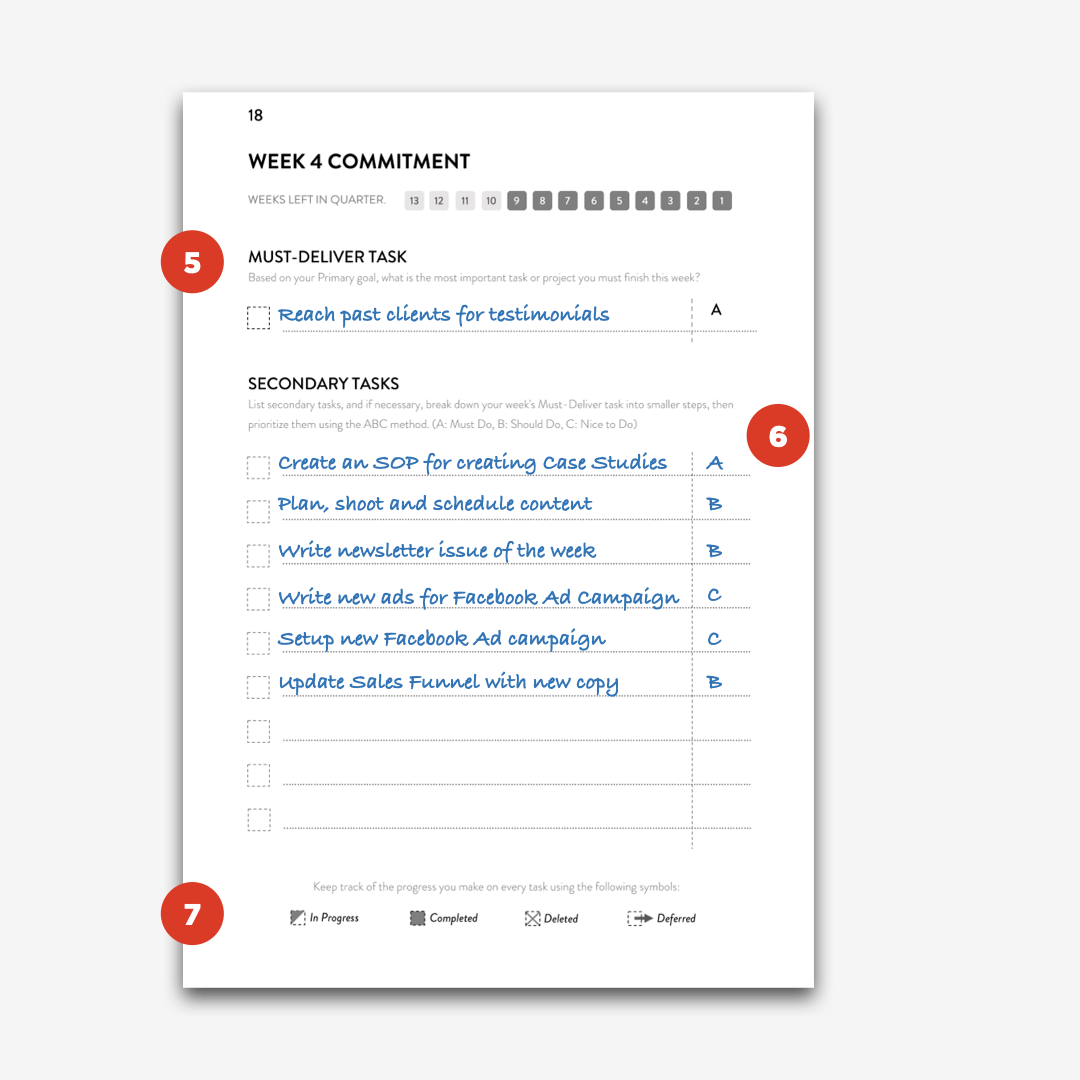The Finisher System
The Finisher System is built on simple concept: Only work on the things that matter, in the right order, on thing at a time until is finished.

Staying consistent with this simple concept can be difficult with so many distractions, and sticking to a plan can feel nearly impossible when confronted with shiny objects.
The Finisher's Journal offers a distraction-free implementation of this idea, ensuring that everyone can benefit from unlimited focus.
Here's how it works
1. Break down your goal into a plan
2. Turn your plan into weekly commitments
3. Turn your weekly commitments into daily priorities
4. Optimize weekly
5. Finisher Journal Hacks
6. Real-life examples

Step 1: Break down your goal into a plan that works
“A dream written down with a date becomes a goal, a goal broken down into steps becomes a plan”

1. Primary Goal
Here's the secret to setting goals that won't make you procrastinate.
➡️ Make your goal meaningful (give yourself a reason to get up)
➡️ Make the deadline real (if you don’t achieve your goal by then there will be consequences)
➡️ Be specific, your goal must have numbers so you can track your progress weekly.
Here some good examples:
✅ Increase clients from 5 to 10 by April 1st
✅ Launch an online store and gain 100 customers by April 1st
✅ Gain 200 customers by December 31st
2. Action Plan
You need an action plan, there is no other way. Without one, you will be easily distracted by shiny objects.
To find the most direct path to achieve your goal, brainstorm 10-15 actions on a blank sheet of paper.Select the 3 most likely to succeed as your action plan and focus on completing them first.
3. Plan Validator Checklist
Use this three-part checklist to ensure that your goal is specific, measurable, and relevant. Additionally, validate that your plan is the most direct path with the highest chances to achieve your outcome goal.
4. Commitment
92% of people fail to achieve their goals because of one little mistake: focusing on the outcome rather than the process (the actions).
Commit to focus on what you can control, and avoid getting distracted by shiny objects.
Step 2: Turn your action plan into weekly commitments
“…a plan backed up by action makes our dreams come true”

5. Must-Deliver Task
Think of your weeks as small projects that will help you reach your goals, following the plan you made.
Your Must-Deliver Task must:
✅ Directly impact your Primary Goal
✅ Be specific, actionable
✅ Within your control
6. Secondary Tasks
Secondary tasks are ideal for breaking down your "must-deliver" task even further.
Use them to write additional tasks that are unrelated to your weekly top priority, and to add reminders you want to keep in mind.
Use the ABC prioritization method to quickly rank secondary tasks by importance (A: Must do, B: Should do, C: Nice to do).
7. Task Tracking Signals
There are four signals that can be used to track the progress of each task: "In progress," "Completed," "Deleted," and "Deferred" in case the task needs to be rolled over into the next week.
Pro-Tip
If a task has been rolled over for more than one week, it is a clear signal that it should be broken down into smaller pieces or deleted if it is no longer relevant.
Step 3: Turn weekly commitments into daily priorities

8. Daily Tasks
Each day, there are only three tasks that you should focus on: Must Do, Might Do tasks(2). Everything else is a distraction. Finishing these tasks in this order is essential for winning the day.
Use the reminders section for additional tasks and reminders you want to keep in mind, the completion of these are completely option.
9. Schedule
Timeboxing your day is one of the core principles of the Finisher’s Journal.
Assigning deadlines to your tasks reduces the urge to procrastinate and promotes a singular focus on each task, preventing distractions.
Start by blocking time for the events for the day, then estimate blocks of time for the top 3 tasks of the day.
Pro-Tip
Keep your schedule clean by only adding the most important tasks and events for the day. Cramming little tasks and reminders into your schedule could trigger overwhelm.
Pro-Tip
Maintain a buffer of at least 15 minutes between tasks to account for unexpected events or tasks that take longer than expected.
Step 4: Optimize weekly: Focus on what works and cut out what doesn't.

This page is that ensure you stack wins after wins, by reflecting on your progress so far and identify optimization opportunities.
Getting clarity on what works and what doesn’t improve…
- Motivation
- Focus
- Consistency
11. Goal Progress Tracker
Every week, visualize your progress, compare it to the previous week, and identify opportunities for growth.
12. Weekly Optimizer
Flip through your daily notes to find valuable knowledge. Your main job is to optimize next week by doing more of what works and less of what doesn't.
13. Highlight Of The Week
What did you learn this week? How can you improve next week?
See the Finisher Journal in action...
Real-life examples





